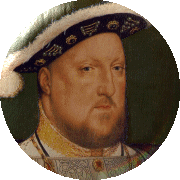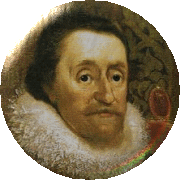Robert Catesby
Robert Catesby's Coventry connection
Robert Catesby was the ringleader of the 1605 Gunpowder Plot, but his connections with Coventry have been forgotten over time, which is especially surprising if one considers the amount of property that the family owned in the very heart of Coventry.
This forgetfulness appears to have started in 1605 when all property, lands and family documents were seized by the government after the failure of the plot and the subsequent shooting of Robert at Holbeche House. Catesby and Thomas Percy were standing side by side when they were felled by a single shot.
William de Catesby (c.1310-1383) was a member of a Warwickshire peasant family which had managed to acquire some land. He rose from insignificance to a position of prominence with remarkable rapidity in the 1330s, becoming a knight of the shire in 1339, and an escheator in 1340. Naturally, he was extending his property interests at the same time. As well as rural estates (including the manor of Ladbroke, Warwickshire), he acquired an urban base in the most important midland city of the period, Coventry; his purchases comprised a substantial town house and thirty to forty city tenements, whose rents conveniently paid the running costs of the mansion. His tenants no doubt also provided support in local affairs, should this be needed by such a powerful man. This pattern was surely repeated many times, but his example is unique for us because of a much later occurrence; the attainder of his descendant, Robert Catesby, the Gunpowder Plot conspirator.
Source:
The Catesbys in Coventry: A medieval estate and its archives, by N. W. Alcock

Click on this map to see an enlarged view showing the Coventry land owned by Robert Catesby and his family by 1605.
If it can be assumed that the family would have carried on increasing their ownership of land and property in key areas of the city, then apart from the 'Guilds' they would have been amongst the largest land and property owners in the city. Yet strangely they did not get involved in the running of the city in any way, not even warranting a mention within the membership of the higher ranking officials who ran the city during the 200 or so years of their influence.
It should be noted that Catesby Lane is missing from the list of names in Speed's map of 1610, which was made shortly after the plot, so it is understandable that the name was erased before they produced the map. What a pity there were no newspapers at the time.... what headlines would they have seen?
All the lands and property owned by the family were forfeited to the Crown in 1605, along with the complete family archive, but the Public Records Office holds no deeds or records relating to Coventry.
The Bull Inn
The "Black Bull" Inn, which stood in Smithford Street, was one of the most important inns in Coventry, It was demolished about 1793, and the Coventry Barracks built on the site.
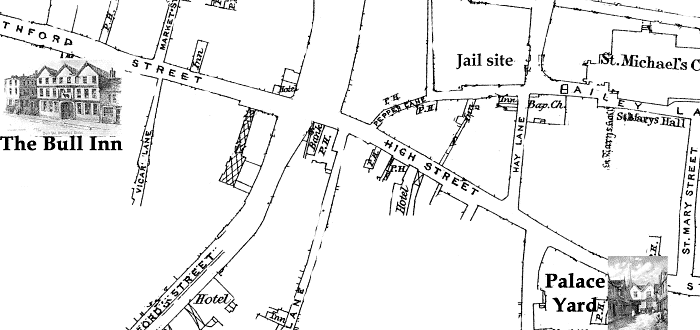
As can be seen, Palace Yard, where Elizabeth was being kept in safety, was only about 400 yards from the Bull Inn, where the conspirators were gathered on that fateful night.
John Wynter and Robert & Stephen Lyttleton, of Gunpowder Plot fame, stopped at the Black Bull Inn on the night of November 4th, 1605. It was from here that the three conspirators went to Dunsmore Heath for the mock hunt to capture James I's daughter, Princess Elizabeth, known by the plotters to be looked after and educated under the care of Lord Harrington at Coombe Abbey.
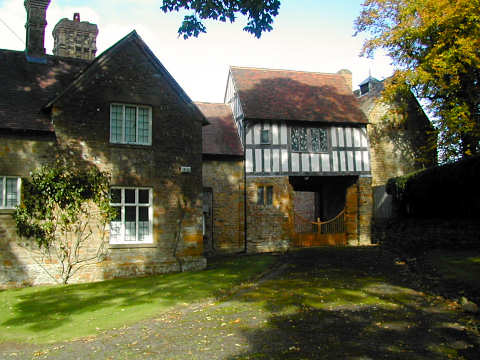
Ashby St. Ledgers, where it was planned to take the princess.
Their plan was to meet as though for the purpose of hunting at Dunsmore Heath, where in the quiet of the country they might secretly make their way across Stretton towards Coombe. Knowing that Coombe was not fortified, there was little to stop their plan, which was to take the princess to Ashby St. Ledgers, where Catesby's mother lived. There she was to be married to a Catholic, and then placed on the throne as Queen.
Curiously enough, it was on this very same day that Princess Elizabeth was brought swiftly from Coombe into the walled city of Coventry, and placed under a heavily armed guard for her safety in the 'Crown House', later known as Palace Yard, in the care of the Hopkins family.
If the plotters had known that just a few hundred yards away from where they were staying was the person whom the whole Gunpowder Plot was about, would they have tried to capture her that night, before Fawkes lit the fuse under Westminster?
Did the plotters have no idea of where the Princess was, and just carried on to Dunchurch on the morning of the 5th November?
Is it perhaps more likely that they heard about the princess being in the city from people coming into the inn, as it would have been the talk of the city? If so, then perhaps in the morning they rode to Dunchurch in a panic knowing their plot had failed.
Ashby St. Ledgers
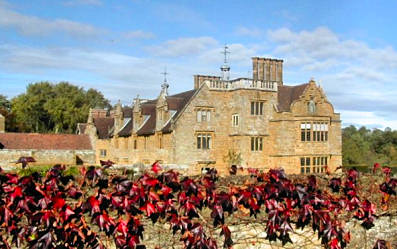
In 1485 William Catesby fought with Richard III at the Battle of Bosworth. William was beheaded and the estate confiscated, but it was later returned to William's son George.
Robert Catesby was the ringleader in the 1605 Gunpowder Plot and it is said that meetings took place in the room above the gatehouse. Robert died at Holbeach House from a pistol shot to the head after a long chase across Warwickshire and Worcestershire. The estate at Ashby St. Ledgers remained in the Catesby family's hands until 1611 when all lands and property belonging to the family where confiscated, including those in Coventry.
In 1903 Viscount Wimborne bought the manor, and employed Sir Edwin Lutyens to work on the house and in the village.
